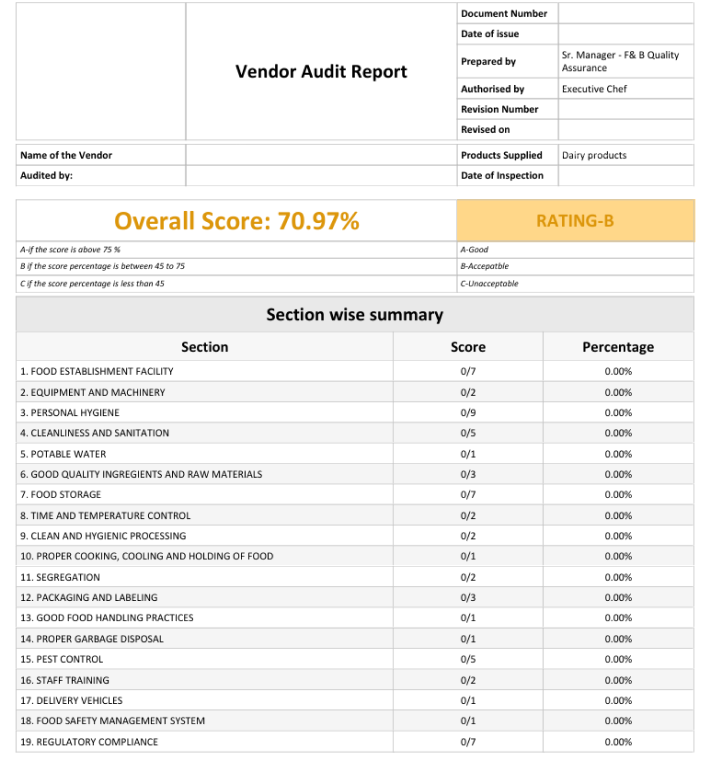- +91 9894 7742 22
- Info@shloklabs.com
In today’s rapidly evolving business environment, outsourcing has become the norm. More and more organizations are delegating critical functions like infrastructure management, software development, logistics, and even manufacturing to third-party vendors. While outsourcing brings flexibility and cost savings, it also opens the door to significant risk. That’s where vendor audits come in.
A vendor audit is not just a checkbox activity — it’s a vital part of managing third-party risks, ensuring quality, and maintaining compliance with industry regulations. Whether you’re a procurement officer, compliance lead, or part of the audit team, understanding vendor audits is key to running a resilient operation.

A vendor audit is a formal evaluation of a third-party supplier’s processes, systems, and documentation. The goal is to ensure they meet contractual terms, internal standards, and regulatory requirements.
For example, in industries like healthcare, vendors that handle sensitive patient information must comply with laws like HIPAA. Similarly, in the food industry, suppliers need to follow safety and hygiene regulations such as FSSAI or HACCP. A vendor audit ensures that these obligations are being met – not just on paper, but in day-to-day operations.

Outsourcing has created vast, interconnected networks of vendors, subcontractors, and service providers. Each new vendor brings with it potential risk — financial, operational, reputational, or legal.
Consider these scenarios:
Vendor audits serve as the first line of defense to prevent such outcomes. They also promote:
Despite its importance, vendor auditing is often seen as a burden. Many organizations still rely on manual processes, which are slow, fragmented, and prone to error. Here’s what a typical audit workflow looks like (and why it frustrates so many teams):
This chaotic process drains time and energy, leaving little bandwidth to focus on actual risk analysis.
Vendor audits aren’t one-size-fits-all. Different types are suited to different kinds of vendor relationships:
These involve physically visiting the vendor’s facility to inspect processes, conduct interviews, and review documentation. They’re best for critical suppliers where process integrity is vital (e.g., manufacturing, pharma, food production).
Conducted virtually through shared documentation, video calls, and digital platforms. Ideal for service providers or when travel is restricted.

A well-structured vendor audit typically involves:

Vendor audits are essentially important in a food and beverage industry. They ensure that ingredients are fresh, packaging is safe, and storage conditions are hygienic. For example, Jio World Centre (JWC) sends auditors to vendors like Britannia to verify the quality of pastries and baked goods, checking if they’re packaged correctly and meet hygiene standards.

From raw material suppliers to contract manufacturers, vendor audits ensure adherence to Good Manufacturing Practices (GMP), batch traceability, and regulatory compliance.
Audits help verify ethical sourcing, quality control, and reliability of delivery schedules — especially for private-label or white-label goods.
Ensuring third-party platforms follow secure development practices, encryption protocols, and uptime standards is crucial for protecting sensitive data.
If audits feel like a never-ending game of follow-ups and spreadsheets, you’re not alone. That’s why platforms like Pro-Inspector exist — to bring order, speed, and clarity to the entire process.
Jio World Centre (JWC) manages high-volume, high-standard food operations — especially during large-scale events. Maintaining food safety, hygiene, and vendor accountability is mission-critical. But before adopting Pro-Inspector, JWC struggled with delayed audits, manual data entry, and scattered insights.
With Pro-Inspector, JWC now runs structured, efficient, and data-driven vendor audits, ensuring every supplier meets safety and quality standards.

Auditors now conduct inspections using tablets or mobile devices through the Pro-Inspector app. This removes the need for paper-based checklists and Excel sheets, saving hours of manual work.
Each vendor audit is automatically scored using predefined section-wise metrics — as seen in the sample audit for Punjab Sindh Dairy. The system categorizes vendor performance into:
This structured scoring helps procurement and QA teams make quick, informed decisions about vendor performance and approval.
The audit is broken down into key categories like:
Each section has its own score and percentage, allowing JWC to pinpoint areas of weakness and guide vendors on corrective actions.
Once an audit is completed, reports are instantly generated and shared with both internal teams and vendors. No need to wait days for summaries or track findings across emails.
One of the standout features of Pro-Inspector during vendor audits at Jio World Centre is the ability to log non-conformities (NCs) on the spot and assign them to the right stakeholders — with photo evidence for clarity.

During an audit of a dairy vendor, the Pro-Inspector app flagged two issues under the Food Storage section:
These findings were:
With this capability, Pro-Inspector turns audits from just a scoring exercise into a powerful tool for continuous improvement and compliance enforcement.
If any section scores poorly, Pro-Inspector flags it as a non-conformity. These issues are logged and tracked until resolution, ensuring accountability from vendors.
Whether it’s Britannia for baked goods or a dairy supplier like Punjab Sindh Dairy, every vendor is audited on the same standardized framework — enabling consistent benchmarking across categories and time periods.
By digitizing the entire process with Pro-Inspector, JWC has transformed vendor audits from a time-consuming chore into a strategic tool for quality assurance and operational excellence.
At its core, a vendor audit is more than a compliance exercise. It’s a way to build trust and foster long-term partnerships. When audits are collaborative rather than confrontational, vendors are more willing to improve — and your business becomes more resilient.
By transforming vendor audits from a pain point into a proactive, strategic function, companies can safeguard operations, uphold brand integrity, and unlock greater value from every supplier relationship.
As vendor ecosystems grow more complex, so does the need for robust audit programs. Manual processes and fragmented tools are no longer sufficient. With a clear strategy, the right tools, and a risk-based approach, vendor audits can become a cornerstone of quality, compliance, and operational excellence.
Whether you’re managing a hundred vendors or just a few critical partners, start building a smarter, more efficient audit program – and turn vendor oversight into a competitive advantage.
Ready to digitize your inspections?
Let Pro-Inspector simplify your audits, streamline compliance, and scale operations—no matter your industry.
Also Read: How NLNG Digitally Transformed Asset Inspections and RFI Workflows with Pro-Inspector
